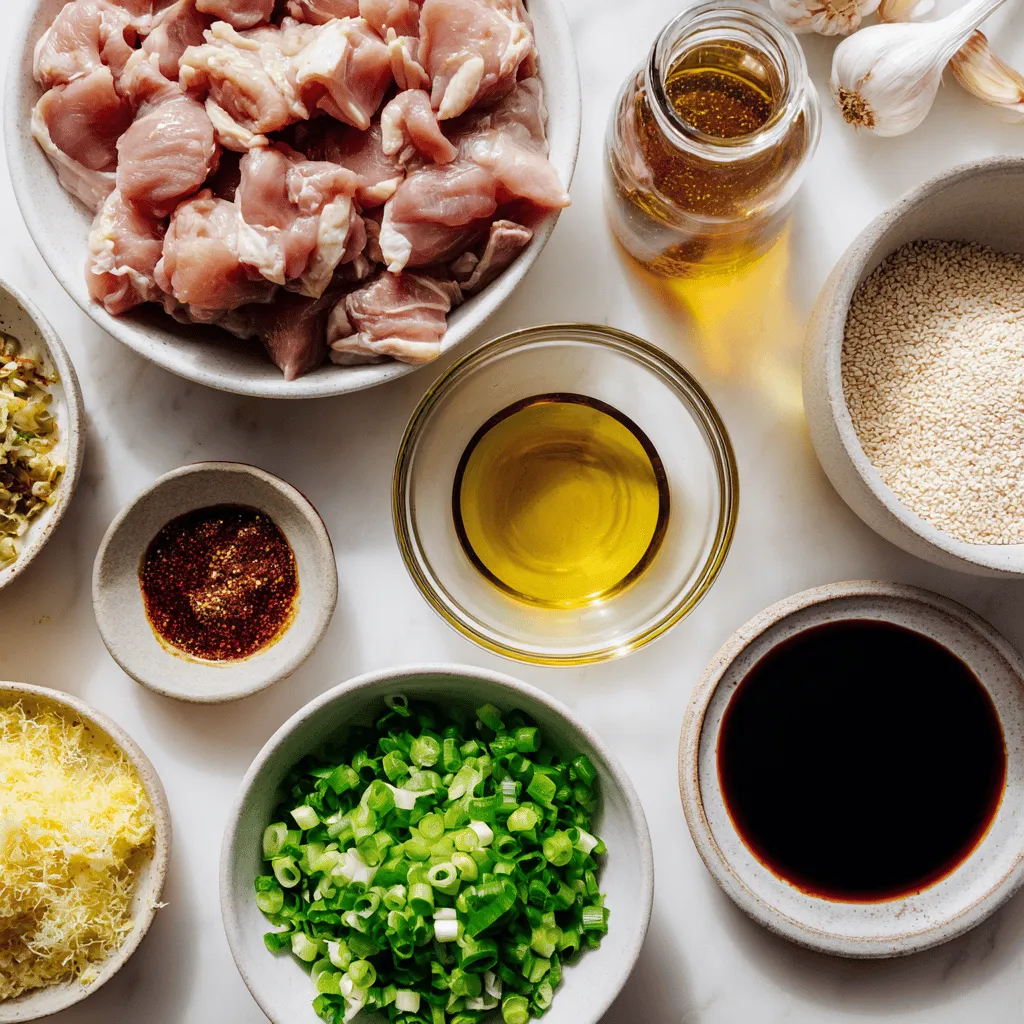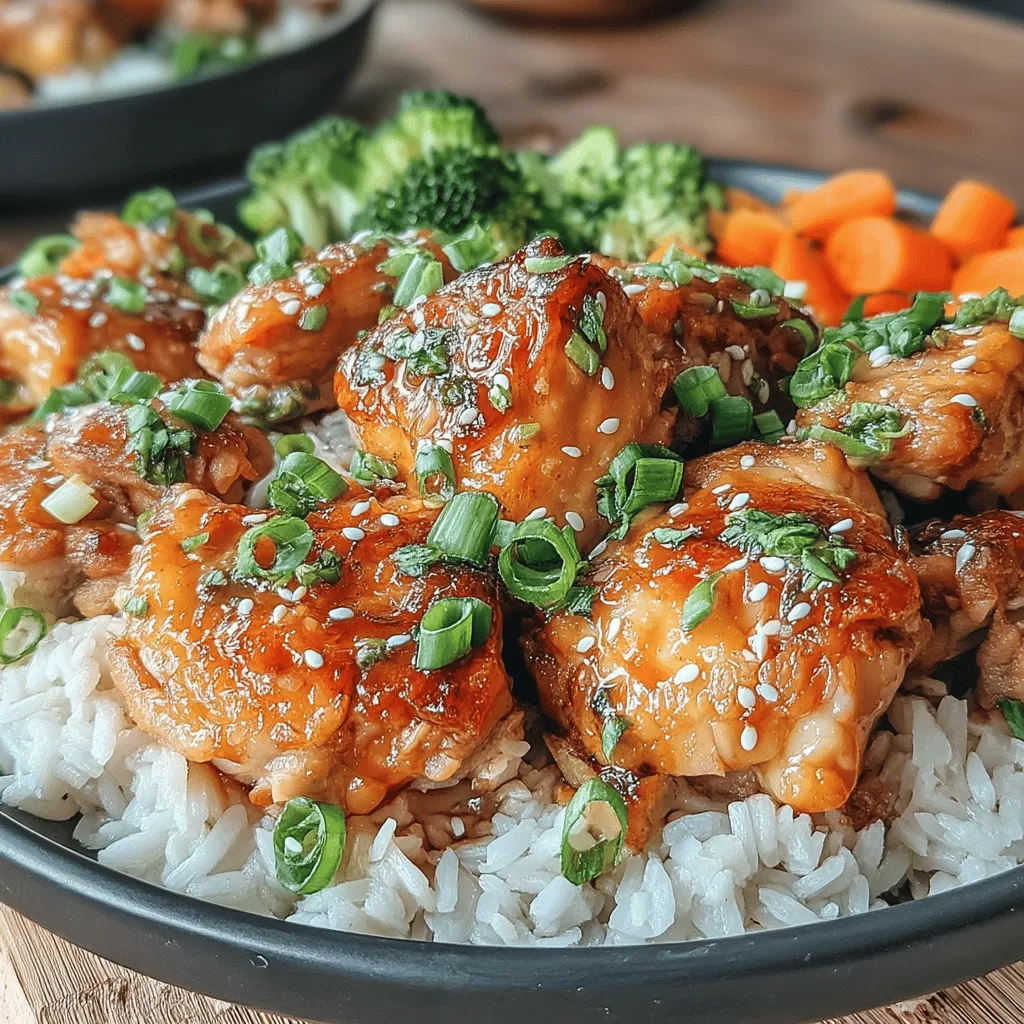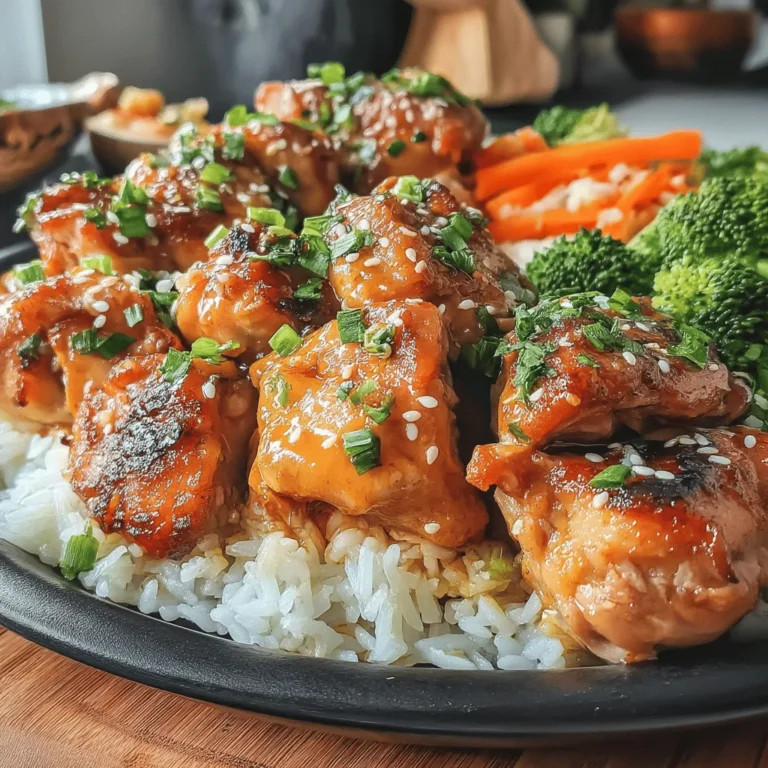Introduction
Quick Sesame Ginger Teriyaki Chicken is a delightful dish that brings together the rich flavors of Asian cuisine in a convenient and speedy manner. Perfect for busy weeknights, this recipe allows you to whip up a delicious meal in under 30 minutes. Its savory, slightly sweet sauce paired with tender chicken makes it a family favorite.
This dish not only satisfies your taste buds but also provides nutritional benefits. The key ingredients like ginger and garlic offer anti-inflammatory properties, while sesame oil adds a nutty flavor that elevates the overall profile of the meal.
Recipe Overview
– Total Time: 25 minutes
– Servings: 4
– Difficulty: Easy
Ingredients
– 1 lb chicken thighs, boneless and skinless
– 1/4 cup soy sauce (low sodium preferred)
– 2 tbsp sesame oil
– 1 tbsp honey or maple syrup
– 2 tbsp rice vinegar
– 2 cloves garlic, minced
– 1-inch piece ginger, grated
– 1 tbsp cornstarch
– 1/4 cup water
– Green onions, sliced (for garnish)
– Sesame seeds (for garnish)

Instructions
1. In a bowl, combine soy sauce, sesame oil, honey or maple syrup, rice vinegar, minced garlic, and grated ginger. Mix well to create the teriyaki sauce.
2. Cut the chicken thighs into bite-sized pieces and add them to the sauce. Let them marinate for at least 10 minutes.
3. In a large skillet, heat a little oil over medium-high heat. Add the marinated chicken and cook until browned and cooked through, about 5-7 minutes.
4. In a small bowl, mix cornstarch with water to create a slurry. Add this to the skillet and stir to combine.
5. Cook for an additional 2-3 minutes until the sauce thickens, stirring frequently.
6. Serve the chicken over rice or noodles, garnished with sliced green onions and sesame seeds.
Understanding Teriyaki: A Culinary Perspective
– Explanation of teriyaki as a cooking method and its origins
– Discussion of the key flavors in teriyaki sauce
– Importance of sesame and ginger in Asian cuisine
Ingredient Breakdown
– Overview of main ingredients and their roles in the recipe
– Chicken thighs: Benefits and why they’re preferred
– Sesame oil: Flavor enhancement and health benefits
– Garlic and ginger: Nutritional values and flavor profiles
– Soy sauce: Low sodium options and alternatives
– Honey vs. maple syrup: Sweeteners and their impact on flavor
– Rice vinegar: Adding acidity and balance
– Cornstarch: Role in sauce thickening and texture
– Garnishes: Importance of green onions and sesame seeds
Preparation Steps: A Step-by-Step Guide

Marinating the Chicken
Marination is a crucial step in achieving flavorful and tender chicken. Allowing the chicken to marinate for at least 30 minutes, or even overnight, enables the flavors of the sesame ginger teriyaki sauce to penetrate deeply into the meat. For optimal absorption, consider using a zip-top bag or a glass dish to ensure that the chicken is fully coated in the marinade. Adding a bit of acidity, such as rice vinegar or lime juice, can also enhance the flavor profile and help tenderize the chicken.
Heating the Pan
Proper heating of the pan is essential for cooking chicken evenly. Preheat your skillet over medium-high heat until it’s hot enough that a drop of water sizzles upon contact. This creates a sear that locks in moisture, resulting in juicy chicken. If your pan is too cool, the chicken will steam rather than sauté, leading to a less desirable texture.
Cooking Technique
Sautéing is the preferred cooking method for this dish due to its speed and ability to create a caramelized exterior while keeping the inside moist. Unlike baking or boiling, sautéing allows for quick cooking at higher temperatures, which enhances the overall flavor. To achieve the best results, avoid overcrowding the pan—cook the chicken in batches if necessary.
Sauce Thickening
To achieve the perfect consistency for your teriyaki sauce, allow it to simmer gently after adding it to the cooked chicken. For a thicker sauce, mix a cornstarch slurry (equal parts cornstarch and cold water) and stir it into the sauce as it cooks. This will create a glossy finish that clings beautifully to the chicken.
Final Touches
Garnishing and presentation play a significant role in enhancing the dining experience. Consider topping your teriyaki chicken with freshly chopped green onions, sesame seeds, or a drizzle of sesame oil for added flavor and visual appeal. Serving the dish in a colorful bowl or on a vibrant plate can also elevate its presentation.
Serving Suggestions
Pairing with Rice
Choosing the right rice can significantly impact the meal. White rice offers a neutral flavor and fluffy texture, while brown rice provides a nuttier taste and additional fiber. For a healthier option, consider quinoa or cauliflower rice, which can complement the teriyaki chicken beautifully.
Vegetable Accompaniments
Incorporating vegetables not only adds color but also boosts the nutritional value of the meal. Steamed broccoli is a popular choice, but you can also consider snap peas, bell peppers, or carrots. These vegetables provide vitamins and minerals, making your dish more balanced and satisfying.
Creating a Balanced Meal
When preparing a balanced meal, aim for a well-rounded plate that includes lean protein, whole grains, and plenty of vegetables. A standard serving size of chicken is about 4 ounces, paired with 1 cup of cooked rice and 1-2 cups of vegetables. This combination ensures you are meeting your nutritional needs while enjoying a delicious meal.
Nutritional Information
Each serving of Quick Sesame Ginger Teriyaki Chicken typically contains:
– Calories: Approximately 350
– Protein: 30 grams
– Fats: 10 grams
– Carbohydrates: 40 grams
This dish is rich in protein from the chicken and offers healthy fats from sesame oil. The ginger and garlic provide additional health benefits, including anti-inflammatory properties.
For those with dietary considerations, this recipe can be made gluten-free by using tamari instead of soy sauce and can be adapted to low-carb diets by substituting the rice with steamed vegetables or cauliflower rice.
Cultural Significance and Variations
Teriyaki chicken holds a special place in Japanese cuisine, often enjoyed at home and in restaurants. Its sweet and savory flavor profile makes it a favorite among many. Variations of teriyaki chicken can be found globally, such as Korean-style teriyaki, which may incorporate gochujang for added heat, or Hawaiian teriyaki, which often includes pineapple.
For those looking to explore different dietary preferences, consider substituting chicken with tofu or tempeh for a vegetarian option. You can still achieve the same delicious teriyaki flavor while catering to plant-based diets.
Conclusion
This Quick Sesame Ginger Teriyaki Chicken recipe highlights the ease of preparation and the delightful flavors of Asian cuisine. With its simple steps and minimal ingredients, it is an excellent option for busy lifestyles while delivering a satisfying and nutritious meal. Embrace the flavors of teriyaki chicken and explore the versatility of this dish in your cooking repertoire.

